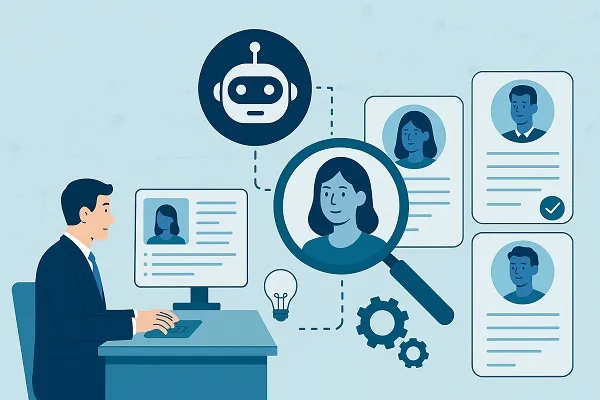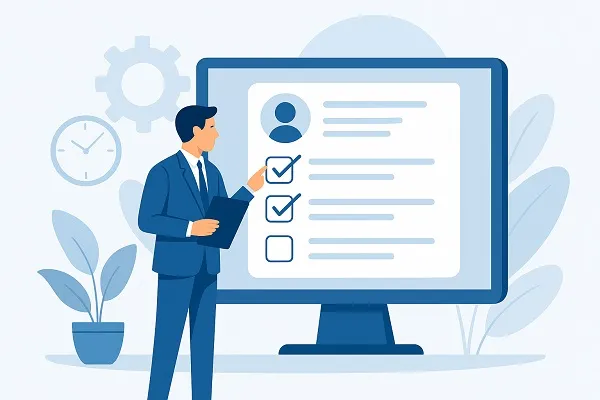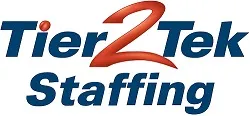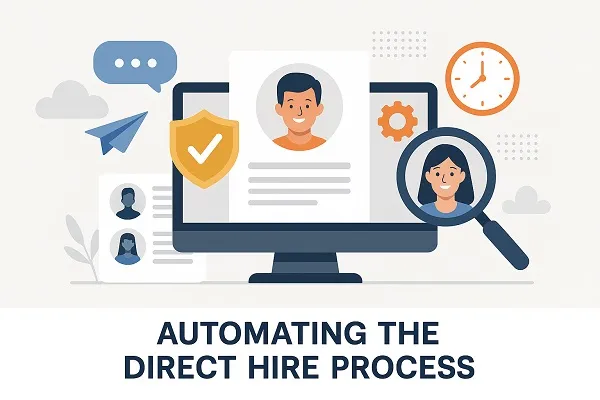Automating the direct hire process is becoming essential for companies aiming to attract top talent efficiently while reducing time-to-fill and recruitment costs. With the competition for skilled candidates increasing and internal recruitment teams under pressure, automation tools are transforming how businesses source, engage, and onboard full-time employees.
By integrating automation into the direct hiring strategy, organizations can streamline repetitive tasks, improve candidate experience, and allow HR teams to focus on strategic hiring decisions rather than administrative processes.
What Is the Direct Hire Process?
Direct hire refers to the process of recruiting candidates for permanent, full-time positions directly within an organization, rather than through temporary or contract roles. Unlike temp-to-hire arrangements, direct hires are placed immediately on the company’s payroll and receive full employee benefits.
This process typically involves:
- Identifying and attracting qualified candidates
- Screening resumes and conducting interviews
- Extending offers and handling negotiations
- Onboarding the new hire into the company
Why Automate the Direct Hire Process?
Manual hiring methods can be slow, error-prone, and resource-intensive. Automating key stages of the direct hire process allows companies to:
- Reduce time-to-fill by eliminating bottlenecks
- Improve consistency in candidate screening and evaluation
- Enhance communication with candidates
- Improve compliance with hiring regulations
- Allow recruiters to spend more time on relationship-building
Let’s explore how automation can be applied throughout the direct hire journey.
Sourcing Candidates with AI and Smart Tools

Automated sourcing tools have revolutionized how recruiters find and connect with qualified talent.
Key Benefits of Automated Sourcing:
- AI-powered resume scanning to match job descriptions with candidate profiles
- Automated job postings across multiple platforms (e.g., LinkedIn, Indeed)
- Talent pool rediscovery by scanning existing applicant databases for matches
- Chatbots and virtual assistants that pre-screen candidates and schedule interviews
These tools ensure that hiring teams can quickly identify high-potential candidates without manually reviewing hundreds of resumes.
Streamlining Resume Screening and Shortlisting
Resume screening is often one of the most time-consuming parts of the direct hire process. Automation helps significantly by:
- Using keyword and skill-matching algorithms
- Filtering applicants based on pre-set criteria
- Ranking candidates by suitability
- Eliminating unconscious bias through objective screening
With screening automation, recruiters spend less time on administrative tasks and more time interviewing top-tier candidates.
Automated Interview Scheduling
Coordinating interview times between candidates, hiring managers, and recruiters can be complex. Automating this step increases efficiency.
Tools for Interview Scheduling:
- Calendar integration platforms like Calendly or GoodTime
- Automated email and SMS reminders to reduce no-shows
- Self-scheduling portals for candidates to choose available time slots
This not only speeds up the hiring process but also creates a more seamless experience for candidates.
Enhancing Candidate Engagement with Automation
Maintaining communication with candidates is crucial throughout the hiring process. Automation ensures that no one feels left in the dark.
Engagement Tactics:
- Automated email workflows to update candidates on their application status
- Personalized messaging based on candidate interactions
- Survey tools to gather feedback on the application process
These tools help maintain interest and foster a positive employer brand.
Using Predictive Analytics in Hiring Decisions

Advanced recruitment automation includes predictive analytics to support data-driven decisions.
How Predictive Tools Help:
- Analyzing past hiring data to forecast candidate success
- Identifying hiring trends and bottlenecks
- Offering insights into which sourcing channels yield the best hires
Predictive tools add a layer of intelligence to the direct hire process, helping recruiters refine strategies over time.
Automating Offer Management and Pre-Boarding
Once a candidate is selected, offer generation and pre-boarding tasks can also be automated.
Examples Include:
- Auto-generated offer letters with digital signature options
- Compliance workflows for background checks and documentation
- Automated onboarding portals for completing HR paperwork
This ensures a smooth transition from candidate to employee and reduces delays in start dates.
Compliance and Data Management
Maintaining compliance with employment laws and data privacy regulations is critical.
Automation can:
- Track and log all candidate communications
- Store resumes and documents securely in applicant tracking systems (ATS)
- Automatically manage consent and data retention settings
Automating compliance helps mitigate legal risks and ensures audit readiness.
Tools That Power Direct Hire Automation
There are several categories of software and platforms that enable automation in direct hiring:
- Applicant Tracking Systems (ATS): Manage job postings, applications, and workflows
- Candidate Relationship Management (CRM): Engage passive talent and nurture leads
- AI-Powered Hiring Platforms: Automate matching, assessments, and communications
- Onboarding Platforms: Digitize the new hire journey
Some popular tools include:
- Greenhouse
- Lever
- Workable
- iCIMS
- Jobvite
How to Get Started with Automation in Direct Hiring

If you’re new to automation, begin by identifying the pain points in your hiring workflow.
Steps to Implementation:
- Audit your current process: Where are delays or inefficiencies?
- Define your goals: Are you trying to reduce time-to-hire, improve quality of hire, or lower costs?
- Choose the right tools: Based on your company size, industry, and budget
- Train your team: Ensure recruiters are equipped to use automation effectively
- Measure impact: Track KPIs such as time-to-fill, cost-per-hire, and candidate satisfaction
Gradual adoption ensures better buy-in from stakeholders and minimizes disruption.
Common Misconceptions About Hiring Automation
Despite the benefits, some companies hesitate to automate due to misconceptions:
- “Automation will eliminate the human touch.”
→ In reality, automation handles repetitive tasks so recruiters can focus on building human connections. - “It’s only for large enterprises.”
→ There are scalable automation tools suited for startups and SMBs. - “It’s expensive and hard to implement.”
→ Many platforms offer affordable, user-friendly solutions with ROI within months.
Real-World Impact of Direct Hire Automation
Companies that implement automation in their direct hire process report measurable benefits:
- Up to 50% faster time-to-hire
- Significant cost savings on sourcing and administration
- Improved candidate experience and engagement
- Higher quality of hires due to better screening and matching
Organizations that prioritize automation are more agile and competitive in talent acquisition.
Automating the direct hire process is no longer a luxury—it’s a necessity for companies that want to compete for talent and scale efficiently. By strategically integrating automation into sourcing, screening, scheduling, communication, and onboarding, organizations can enhance every step of their hiring funnel.
The result is a more efficient, data-driven, and candidate-friendly hiring process that benefits both employers and job seekers. Whether you’re a small business or a large enterprise, the right automation strategy can transform your approach to direct hiring.
Content reviewed and published by Tier2Tek Staffing Editorial Team .

